|
 |
|
Beginnings
Enamelled iron plate signs were the
first permanent form of advertising poster. They are both
waterproof, heatproof, easily washable, and are free from fading. In the
late nineteenth century, and for much of the twentieth
century they were produced in vast numbers.
The process was developed by Benjamin
Baugh in Birmingham, and patented in 1859. He ran Salt’s
Patent Enamel Works in Bradford Street, Birmingham. The
company displayed several signs at the 1860 Trade Exhibition
in London, and produced signs for a number of prominent
buildings. In 1889 he opened an enamel sign
factory at Selly Oak, Birmingham, under the name of The
Patent Enamel Company Limited. This was thought to be
the world’s first dedicated enamel sign factory, but evidence has come
to light which proves that the Chromographic Enamel Company
Limited, at 531 Dudley Road, Wolverhampton, began producing
signs three years earlier.
The Chromographic Enamel Company Limited was founded in
May 1886 in a rented factory on the corner of Dudley Road,
and Frederick Street, Wolverhampton. Initially there were
just six people working in the factory, but within twenty
years the workforce had grown to around 200.
The following, is part of a letter received by the
company secretary, Mr. Singleton on July 19th, 1906, in
readiness for a Board meeting. It includes a reference to
the company's start date: |
| July 19th, 1906 Dear
Sir,
With regard to your Board
Meeting tomorrow, I wish to bring to your notice
a point which has not properly been thought of,
and no doubt will be of interest to your
Directors.
It is just 20 years since
this Company commenced business (May 1886) in a
comparatively small way, and it speaks highly
for the Managing Directors; Mr. Singleton,
yourself as Secretary; and the staff at the
works for the splendid development of the
business during this time. I myself certainly
take credit for some little portion of the work
that has been done in building upon sheer merit
alone, a business starting with half a dozen
workpeople and which now finds employment for
200. |
|
| Another reference for the early starting date can be
found in the 'Illustrated Towns of England Business Review:
Wolverhampton' published in 1897 by the Industrial
Publishing Company. |
|
The
Chromographic Enamel Company, Ltd., Dudley Road.
This important business was
established some twelve years ago. The works and
offices in Dudley Road provide all essential
accommodation, while the plant, etc. is equally
satisfactory. A new works has just been erected
in Church Lane for manufacturing enamelled stove
plates for lining the interior of gas stoves.
This firm carries on the manufacturing of every
description of enamelled iron advertisement
plates, in any colour or design, and employ a
large number of hands.
The Chromographic Enamel
Company, Limited are contractors to Her
Majesty's Government, while they embrace as
patrons most of the large and leading firms in
the country. Samples of the work of this firm
may be seen at all the principal railway
stations. Their productions generally are of
world-wide reputation. Telephone No 7027.
Telegrams:-" Chromo, Wolverhampton." |
|
|
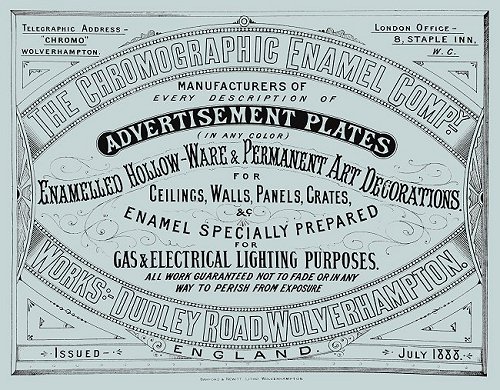
The company's July 1888 catalogue. |
| Chromographic specialised in all kinds of enamelled iron
plates and signs for many applications, including
advertising, municipal signs, park notices, lavatory
notices, tram notices, railway signs, railway station names,
railway wagon plates, railway caution plates, street name plates, door number
plates, cab fare plates, cabmen's badges, ships'
door plates, hearth plates, stove linings, clock dials, pit notice
plates, coal mine regulations plates, decorative plates for
ceilings, walls, and grates, ornamental wrought iron with
decorated plates for use as fire screens, ornamental wrought
iron signs, skeleton letters, and enamelled iron reflectors
and cones for gas and electric lighting. |
|
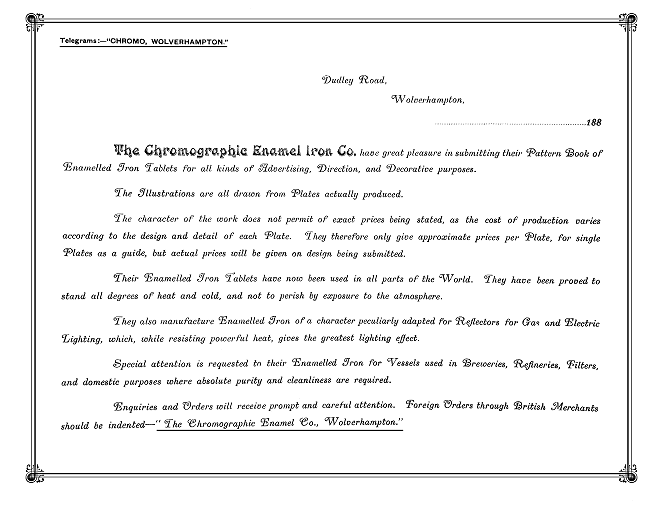
From the 1888 pattern book. |

The location of the factory, based
on the 1901 Ordnance Survey map. The company rapidly
grew during its first fifteen years, as can be seen by
the size of the factory. |
| Many of the firm's products were sold throughout the
world. By 1895 weekly deliveries were made to customers in
New York. Orders were frequently received from Montreal,
Holland, Germany, New Zealand, and India. One of the largest
customers in New Zealand was the General Post Office which
ordered all kinds of signs. In 1892 the company received an
order for 450 gas engine plates from Stockholm, 1,500 plates
for Messrs. Reckitts, and a large order from brewers in
Nottingham. In 1898 the Thames Conservancy ordered 310
launch pass plates, 172 lock toll plates, and 3,000 private
pleasure vessell plates. In the same year large numbers of
crown plates and door plates were sold. Orders were also
received from the railway signalling company Saxby and
Farmer of London, for iron signal arms and plates. |
|
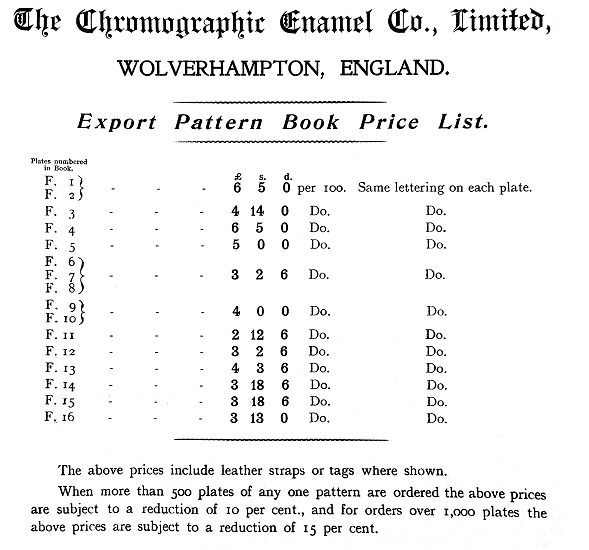
A price list from an export
pattern book dating from around 1890. |
|
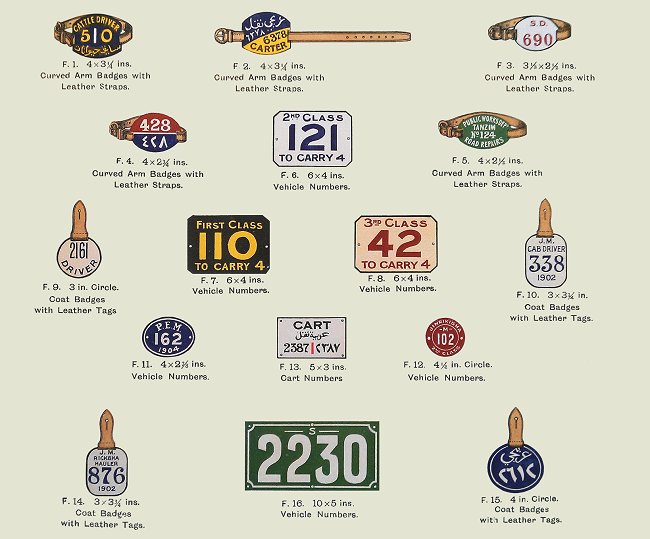
Some of the plates in the export
pattern book. |
|
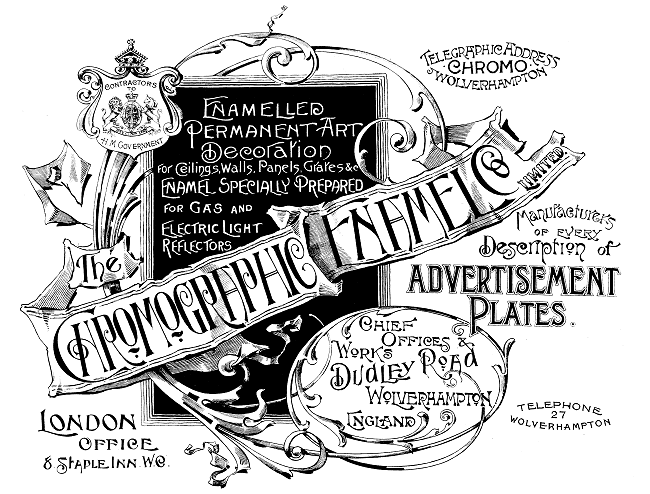
An advert from the late 1880s
which includes the address of the firm's London office. |
| The staff annually raised money for local good causes.
In 1891 four guineas was donated to Wolverhampton Eye
Infirmary, and four guineas was donated to Wolverhampton
Women's Hospital. |
|
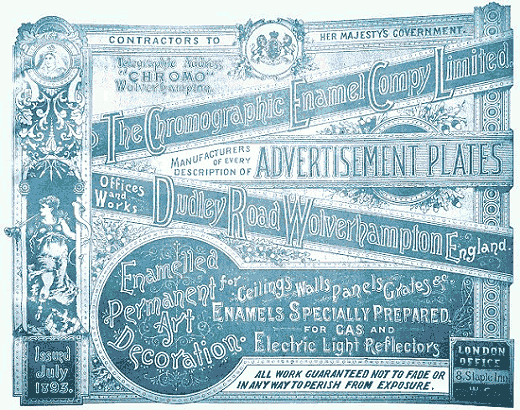
The cover of the July 1893
catalogue. |
|
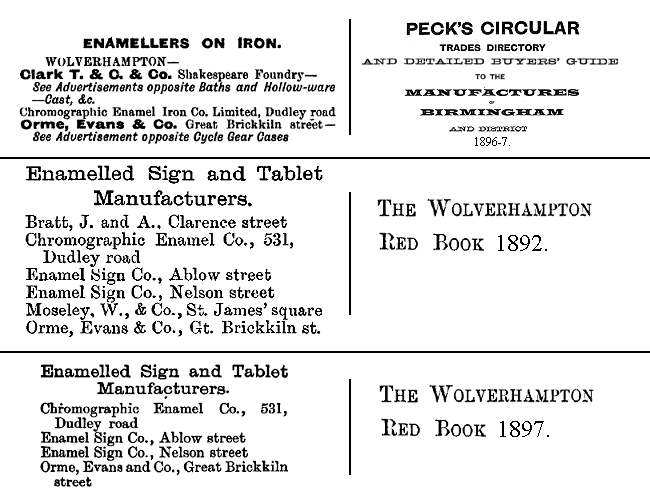
Entries in trade directories. |
| The remainder of the story is told in the
following sections: |
|